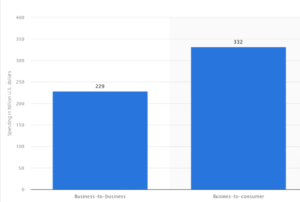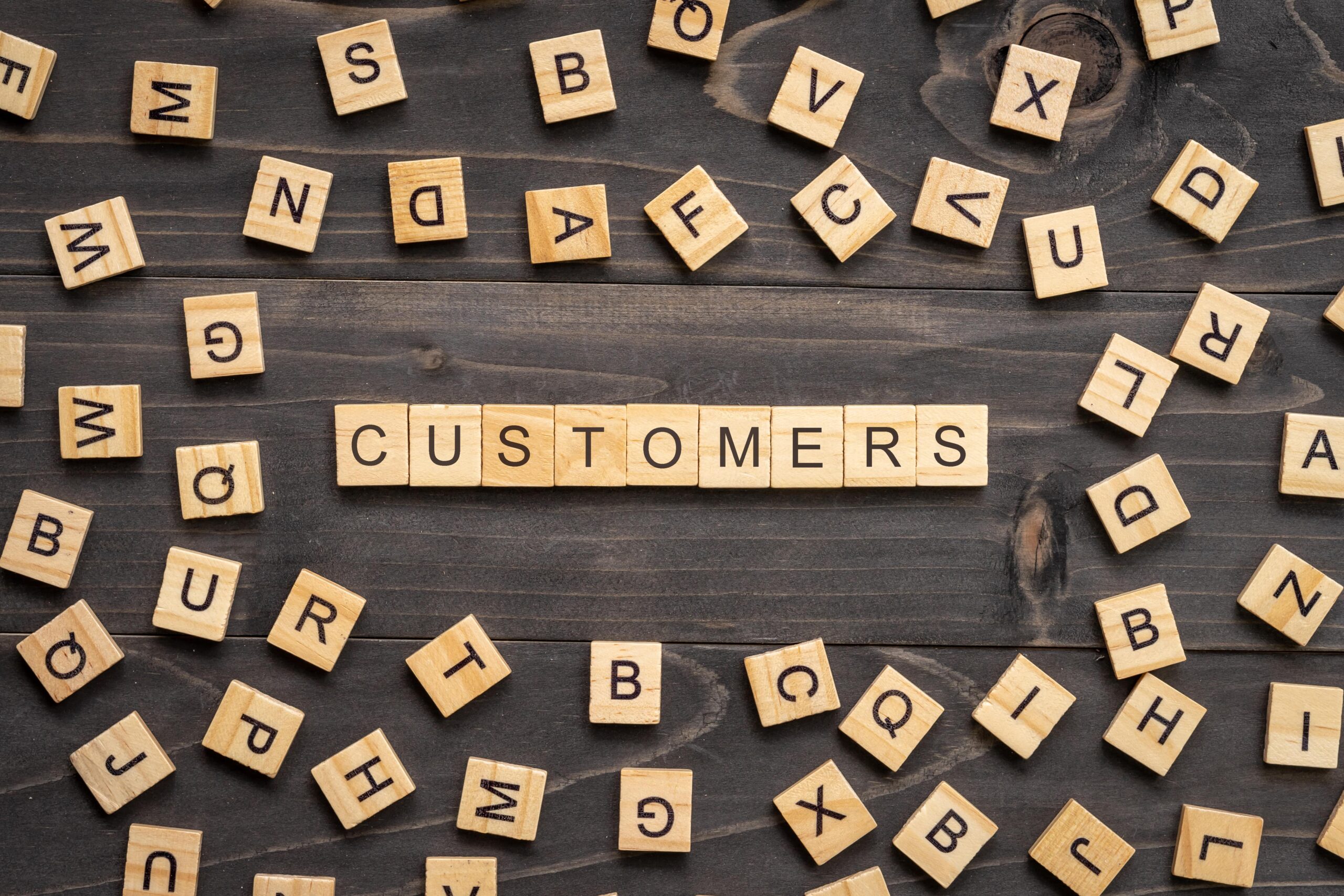Are you serving individual customers, a business, or BOTH?
You’re probably lost in the B2B and B2C digital marketing gap.
Within the world of digital marketing, two specific sectors exist—B2B and B2C.
In 2015, Statista even showed a graph comparing US brand activation marketing spending by the end-user sector.

But with the evolving landscape of online marketing, finding common ground between the two is increasingly important.
In this article, we’ll explore B2B and B2C digital marketing and suggest actionable strategies for bridging the gap between them.
And with that, let us help.
Interested?
Then let’s go.
Understanding the two worlds: B2B vs. B2C digital marketing
First, let’s define B2B and B2C marketing.
B2B stands for business-to-business, meaning your marketing efforts are aimed at other businesses or organizations. B2C, on the other hand, stands for business-to-consumer. Thus, your marketing efforts target individual consumers.
And to effectively overcome the two, it’s crucial to be familiar with the fundamentals of both approaches. Therefore, let’s have a comprehensive understanding of their differences and similarities.
Difference between B2B and B2C digital marketing:
-
- Sales cycle length:
Primarily, the difference between B2B and B2C is in the sales cycle. B2B marketing typically involves longer and more complex decision-making processes. That’s because businesses require in-depth research, consultations, and negotiations before committing to a purchase. The decision-making process is generally much slower, and it can take many meetings before it’s finalized.
In contrast, B2C marketing often features shorter sales cycles—where consumers make impulsive or quick purchasing decisions. These purchases have a much faster conversion time with few in-steps between the initial impression to making the final decision
-
- Target audience:
Again, B2B marketing focuses on targeting specific businesses, such as other companies or organizations. So usually, the audience is composed of key decision-makers, executives, or specialized professionals who evaluate products or services based on their impact on business operations, cost-effectiveness, and ROI.
Meanwhile, B2C marketing targets masses or individual consumers who make purchasing decisions based on personal preferences, emotions, and desires.
-
- Appeals:
B2C marketing relies heavily on emotional appeals like connecting with consumers’ desires, aspirations, and personal needs. It taps into emotions such as happiness, fear of missing out, or a sense of belonging to drive purchasing decisions. B2C marketing is all about simplification and speaking in straightforward language.
On the other hand, B2B marketing tends to rely more on logical, data-driven, and rational appeals. Decision-makers are motivated by efficiency, productivity, cost savings, and long-term benefits. So, B2B marketers use detailed case studies and in-depth reports to demonstrate ROI and develop business strategies.
-
- Used social media platforms
While both types of businesses can benefit from social media, B2C companies tend to succeed more on platforms like Instagram and Facebook, where they can connect with individual consumers.
B2B companies, though, often find more success on LinkedIn and other professional networking sites.
Similarities between B2B and B2C digital marketing:
-
- Engaging content:
Both B2B and B2C marketing require engaging content. They benefit greatly from valuable and relevant content that establishes the brand’s credibility, educates the audience, and helps build trust.
Whether it’s informative blog posts, engaging social media content, or comprehensive product descriptions, compelling content is a shared necessity in both domains
-
- Good communicators:
Clear and effective communication is essential in both B2B and B2C marketing. It involves conveying key messages, addressing pain points, and showcasing the unique value proposition.
Whether it’s through professional presentations, persuasive sales pitches, or engaging social media campaigns, effective communication is critical to capture the attention and interest of the target audience.
-
- Branding:
B2B and B2C businesses must establish distinctive brand identities and differentiate themselves from competitors. Branding includes a unique brand story, consistent visual identity, and distinct brand voice.
So now that we have explored the differences and similarities between B2B and B2C digital marketing approaches, let’s see some real-world businesses operating in these domains.
Examples of B2B and B2C Businesses:
-
- B2B businesses often include software companies, consulting firms, manufacturers, and suppliers.
Salesforce is a good example here. It’s a leading customer relationship management (CRM) platform that caters to businesses of all sizes. They provide a range of cloud-based solutions that help companies manage their sales, marketing, customer service, and other business operations.
Salesforce primarily targets B2B customers, offering them tools and technologies to streamline their processes and enhance customer engagement.
2. B2C businesses exist across various industries, including retail, fitness, hospitality, e-commerce, and entertainment.
For instance, a clothing brand may focus on selling trendy apparel and accessories directly to consumers. A hotel chain caters to individual travelers seeking comfort, convenience, and memorable experiences.
Popular examples here are:
Amazon—the world’s largest online marketplace (a prime example of a B2C business), and Nike—a globally recognized sportswear brand that primarily targets individual consumers.
Marketing to both? Challenges when promoting to both B2B and B2C audiences
Challenges arise when marketers venture into the realm of targeting both B2B and B2C audiences—the lines between these two worlds are blurring
Here are some challenges:
-
- Strategizing different messages for different audiences
-
- Executing different deliverables
-
- Using different language and tone
Consequence of NOT effectively addressing these challenges
Failure to address the challenges posed by marketing to both B2B and B2C audiences may result in ineffective targeting— and that could end in missed opportunities, wasted resources, and diluted brand messaging.
Strategies for bridging the gap between the marketing approaches
Today, consumers (whether B2B or B2C end-users) expect the same personalized experience and level of engagement. This shift in consumer expectations has made it necessary for businesses to adopt strategies that bridge the gap between B2B and B2C marketing.
So we list 4 actionable strategies for filling in the differences between the marketing methods.
#1 Fully understand your intended audience
There’s a huge difference between B2B and B2C marketing audiences. So to bridge the gap between them, start by gaining a deep understanding of your target customers.
Implement techniques like personalization and segmentation to tailor your messaging and offerings to their specific needs. With the rise of AI and data analysis tools, brands can collect and analyze consumer data to create more personalized and segment-focused experiences.
#2 Craft a consistent brand message
The first step here is to define your brand. Ensure you clearly understand who you are, what you offer, and how you want to be perceived in the market. A clear definition of your brand will help you develop a consistent brand message and a brand narrative that communicates your core values and resonates with both business and consumer audiences.
No matter what marketing channel your audience found you, ensure your brand has a cohesive voice. Craft marketing materials focused on common goals that can unite the two approaches.
#3 Integrated marketing campaigns
A successful marketing campaign integrates multiple touchpoints. And an effective strategy for bridging the gap is to implement integrated marketing campaigns. An integrated marketing campaign leverages multiple channels to create a seamless customer journey that combines both B2B and B2C marketing tactics.
Also, you might want to consider partnering with a digital marketing agency that can provide a range of services tailored to both B2B and B2C needs— just like BrightMinds digital marketing agency.
Our team can provide services that allow you to maintain consistent messaging across various channels and leverage the strengths of each platform to maximize impact.
Here are some:
-
- Website development
-
- Social media management
-
- Sales and marketing campaigns
-
- Facebook and Instagram ads
-
- SEO
#4 Spot the cross-channel opportunities
Achieving an integrated customer experience requires identifying opportunities to take different channels and join their efforts. For example, the use of emails. You can leverage email marketing to drive traffic to an event or point of sale. You can then run a product demo on a B2B website, using the same thematic banners or promotional content for a B2C audience too.
Also, take note. The silos between sales and marketing teams can prevent an integrated approach to marketing channels. So, make sure both teams are working together by sharing campaign data, involving each other in the planning process, and setting shared goals.
Never worry about B2B and B2C digital marketing again
If you’re a business owner, it’s important to understand the differences between B2B and B2C digital marketing and the similarities. And if you’re targeting both—embracing the challenges of marketing to both B2B and B2C audiences can be worth the effort.
By incorporating the hybrid strategy, businesses can unlock the potential for increased revenue generation. Here are some strategies we recommend:
-
- Fully understand your intended audience
-
- Craft a consistent brand message
-
- Employ integrated marketing campaigns
-
- Spot the cross-channel opportunities
So, if you feel it’s time to dive in on this transformative journey, don’t handle it alone—seek the expertise of a reliable and experienced digital marketing agency like BrightMinds. With our team’s innovative approach, we can guide businesses like yours in developing integrated marketing strategies that effectively engage both audiences.


